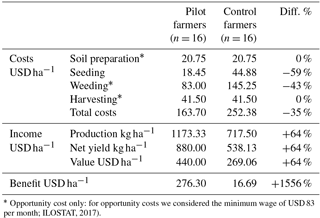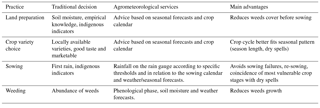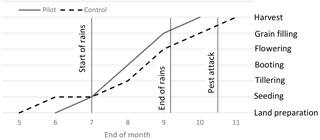Agrometeorological services for smallholder farmers in West Africa
Vieri Tarchiani
José Camacho
Hamidou Coulibaly
Federica Rossi
Robert Stefanski
Climate variability and change are recognised as a major threat for West African agriculture, particularly for smallholder farmers. Moreover, population pressure, poverty, and food insecurity, are worsening the vulnerability of production systems to climate risks. Application of Climate Services in agriculture, specifically Agrometeorological Services, is acknowledged as a valuable innovation to assist decision-making and develop farmers' specific adaptive capacities. In West Africa, the World Meteorological Organisation and National Meteorological Services deployed considerable efforts in the development of Agrometeorological Services. Nevertheless, the impacts of such services on West African farming communities are still largely unknown. This paper aims to delineate the added value of agrometeorological services for farmers within the Agriculture Innovation System of Mauritania. The results of this quali-quantitative assessment demonstrate that farmers use agrometeorological information for a variety of choices: making strategic choice on the seed variety and on the geographical distribution of plots, choosing the most appropriate planting date, better tuning crop development cycle with the rhythm of the rains and choosing favourable periods for different cultural operations.
Globally, the effects of all these good practices can be summarized by an increase of crops productivity and a decrease of cropping costs (including opportunity cost) in terms of inputs and working time.
- Article
(327 KB) - Full-text XML
- BibTeX
- EndNote
Farming communities in West Africa have survived long series of climate fluctuations in the past by adapting to widely varying weather conditions. Nevertheless, climate change and increasing extreme events, combined with population pressure, poverty, and food insecurity, are worsening the vulnerability of production systems to climate risks (Antle et al., 2004). Therefore, traditional knowledge may become inadequate to sustain crop production under unprecedented climatic scenarios. The World Meteorological Organization (WMO) has recognized the importance of Climate Services (CS) to bridge the gap between climate information developed by scientists and providers of services and the practical needs of users (WMO, 2011). CSs are actually acknowledged as a key innovation opportunity in agricultural management by the Global Framework for Climate Services and the Global Alliance on Climate Smart Agriculture (GASCA). On the other hands, most of West Africa countries recognized with the National Frameworks for Climate Services the need of socio-economic sectors to acquire and integrate weather and climate data and information.
Agrometeorological Services (AS) for farmers, as defined and exemplified by prof. Stigter (2007, 2008, 2010, 2011) during the last decade, serve to support the whole set of farmers' tactical and strategic decisions.
Since 1982, agrometeorological advises have been operationally applied in farming decision making in Mali through an innovative, for that time, approach to bring agrometeorological information to rural communities and authorities. The outcomes showed that the regular provision of agrometeorological information can help farmers to manage better the risks associated with increased climate variability (Helmuth et al., 2007) and encouraged further development of Agrometeorological Services in the region.
Seasonal climate forecasts marked a critical step forward in the region thanks to the PRESAO (West African Climate Outlook Forums). The advent of seasonal forecasting expanded the lead-time of farmer-relevant information and contributed to rise the interest in applying CS to agriculture. Tarhule and Lamb (2003) already documented a positive perception of farmers and local stakeholders toward the use in agriculture of such seasonal climate forecasts. However, counterfactual evaluations of agro-economic impacts of seasonal forecasts for smallholder farmers in sub-Saharan Africa still lack (Meza et al., 2008). In 2010, Sultan et al. demonstrated through an ex-ante evaluation that the economic value of forecasting a dry year might lead to an 80 % increase in income with respect to the control strategy. So far, there is limited knowledge regarding the implementation and impacts of CS in reducing exposure and vulnerability to climate risks in sub-Saharan Africa.
During last 10 years, the World Meteorological Organization engaged in supporting West Africa countries in the transition toward Climate Smart Agriculture. The approach builds on the concept of Agriculture Innovation Systems (AIS), which encompasses traditional agricultural research, extension and education agencies, including farmers as well as other private and public actors such as National Meteorological Service (NMS), media and NGOs. From this perspective, the innovation is the promotion of “different ways of thinking and different ways of doing things” (Knickel et al., 2009). The approach is therefore based on the development of collaborative networks where information is exchanged and learning processes happen, taking into account the specific socio-economic structure (Hubert et al., 2012).
The hypothesis is that ASs can effectively improve agricultural productivity and increase farmers' income. This paper aims to delineate the added value of agrometeorological services for farmers within the AIS of Mauritania. Data and information reported in this paper have been collected within the WMO METAGRI OPS Project during 2015 and 2016 cropping seasons.
In addition to this introduction, this paper is organized in three sections. The first presents materials and methods including the conceptual innovation framework in CS and the relation with AISs. The second section reports on the results of the impact assessment. The conclusion develops a discussion on limits and conditions for the use of services and makes some recommendations.
The research questions addressed by this work can be summarized in “Which are the impacts of ASs on farmers' behavior?” and “Which is the added value of ASs for farmers within the AIS of Mauritania?”. To respond, a quali-quantitative assessment of impacts on farmer's behavior and crop productivity has been carried out during 2015 and 2016 cropping seasons in Mauritania. The assessment was made on four sites. In each site, two pilot and two control farmers were selected in each site. In the field of each farmer, three plots were identified. Pilot farmers are those who were trained and received agrometeorological information and advice during the cropping season. Control farmers are normal farmers not participating in project activities, randomly selected in the neighborhood.
Specific survey tools have been designed and applied according to the research questions and the time of survey (Table 1).
Variables were averaged by parcel (three plots per parcel) and then analyzed. A Student t test was applied to the two data sets (pilot and control farmers) in order to identify statistically relevant differences in averages.
The NMS of Mauritania is engaged since 2008, with the support of WMO, in providing ASs to rural communities (Tarchiani et al., 2017), which can be summarized as:
-
information on weather extremes and climate change,
-
provision of training and rain-gauges to farmers,
-
sowing optimum calendar to be used in association with observed rainfall,
-
seasonal forecasts, expected sowing periods and related advices,
-
weather forecasts,
-
10-days agrometeorological advices.
Training of farmers and dissemination is mainly done through Roving Seminars (RS) on Weather, Climate and Farmers. The RS involve entire communities of farmers in a one or two day seminar with an exponential diffusion at local level. The contents of the RS are adapted to the local conditions (Stigter, 2016).
Table 4Average agro-economic performance on 2015 and 2016 seasons.

* Opportunity cost only: for opportunity costs we considered the minimum wage of USD 83 per month; ILOSTAT, 2017).
The AIS of Mauritania is characterized by a strong partnership among NMS with other technical services and international organizations. At local level, NMS collaborates, mainly for dissemination of information, with the agricultural extension service, NGOs, farmers' organizations, national and local radios, cellphone companies and traditional griots1.
The results demonstrate that farmers use agrometeorological information for a variety of choices, as showed in Table 2.
Globally, the effects of all these good practices can be summarized by an increase of crops productivity (Table 3) and a decrease of cropping costs (including opportunity cost) in terms of inputs and working time (Table 4).
The average of 2015 and 2016 growing seasons shows that, in Mauritania, sorghum yields increased by 64 % thanks to ASs. Main impacts affecting yield relate to the choice of the variety (2015 and 2016 seasons have been shorter than normal) and of the sowing date, the latter avoiding failures and loss of seeds. The choice of a short cycle variety allowed to minimize the negative effects of an earlier than normal rains cessation, in both years, and, in 2016, also to avoid pests attack observed at the end of the season (Fig. 1).
In terms of costs, main differences are related to opportunity costs of working time, while direct costs are negligible for most cropping practices. Pilot farmers saved 12 % of total farming expenses (including opportunity costs) compared to control ones just in terms of number of seeding, without considering crop development effects. On the contrary, losses in terms of opportunity costs due to additional weedings for control farmers have been estimated at 25 % of their total costs (Table 4).
In terms of benefits, the difference between pilot and control farmers including opportunity cost is USD 260 per ha (+1556 %). Such huge difference should not astonish, because an important component is due to the opportunity cost of time that pilot farmers saved thanks to agrometeorological services.
Innovation through the introduction of Climate Services in agriculture is a powerful way to assist decision-making and develop farmers' specific adaptive capacities. The results demonstrate that farmers use agrometeorological information for a variety of choices: making strategic choice on the seed variety and on the geographical distribution of plots, choosing the most appropriate planting date, better tuning crop development cycle with the rhythm of the rains and choosing favorable periods for different cultural operations. Globally, the effects of all these good practices and behavioral changes can be summarized by an increase of crops productivity and a decrease of cropping costs in terms of inputs and working time. The latter represents a major benefit for farmers if contextualized in the local perception of time-use and its opportunity cost for smallholder farmers in sub-Saharan Africa (McCullough, 2017). Indeed the time-sensitive nature of agricultural practices create labor supply bottlenecks in specific periods further limiting agricultural productivity.
Even if limited in time and in the sample, this counterfactual evaluation contributes to generate evidence regarding the ultimate impacts of Climate Services in agriculture. Indeed ex post quantitative studies still lack in Sub-Saharan Africa (Meza et al., 2008; Vaughan et al., 2017).
Observed behavioral changes demonstrate also that targeted agrometeorological training and awareness rising programmes can effectively strengthen the relationships and trust among farmers and the other components of the AIS.
Nevertheless, many challenges remain on the road to scale up agrometeorological services for wider communities of smallholder farmers in West Africa. One of the main criticalities is the need to enhance the role of information and communication technologies for accurate, reliable and timely climate information.
Recommendations for further developing the use of agrometeorological services include:
-
consider Weather and climate information embedded in agricultural development packages, and integrate it with other adaptation strategies such as agroforestry, soil and water conservation, agro-ecological processes etc.
-
improve communication; there is a need for more participatory and innovative ways of communication, adapting new technologies that can be adopted by small farmers.
-
local challenges and barriers must be overcome considering specific local needs, indeed, despite the fact that advises are the result of sound scientific research, their adoption depends on broader local social and economic, contexts.
-
evolve the approach from projects to AISs (innovation/sustainability) and rethink the extension approach including in a more structured way other components of the AIS such as privates, NGOs, input suppliers, etc.
-
need to continue impact assessments and improve them in terms of timeframe and spatial extent,
-
better analyze behavioral and social aspects in order to guide the bottom-up design of agrometeorological services according to the “farmer first paradigm”.
Data are publicly accessible on request to the authors.
VT, HC and JC designed the evaluation under the supervision of RS. HC carried them out. FR supported the scientific framing of the study. VT prepared the manuscript with contributions from co-authors.
The authors declare that they have no conflict of interest.
This article is part of the special issue “17th EMS Annual Meeting: European Conference for Applied Meteorology and Climatology 2017”. It is a result of the EMS Annual Meeting: European Conference for Applied Meteorology and Climatology 2017, Dublin, Ireland, 4–8 September 2017.
The METAGRI OPERATIONAL Project (2012–2015) has been funded by the Ministry of Foreign Affairs of the Norwegian Government but also by the Government of Greece and minor contributions from AEMET (Spain), EUMETSAT and WMO regular budget.
We gratefully remember Gianpiero Maracchi, President of the Accademia
dei Georgofili, former Director of IBIMET-CNR, Professor Emeritus of the
Florence University and former vice-President of WMO-CAgM for his valuable
advice and teachings during a life dedicated to climatology and agro-meteorology.
Edited by: Josef Eitzinger
Reviewed by: Anna Dalla Marta and Levent Saylan
Antle, J. M., Capalbo, S. M., Elliott, E. T., Paustian, K. H.: Adaptation, Spatial Heterogeneity, and the Vulnerability of Agricultural Systems to Climate Change and CO2 Fertilization: An Integrated Assessment Approach, Climatic Change, 64, 289–315, https://doi.org/10.1023/B:CLIM.0000025748.49738.93, 2004.
Helmuth, M. E., Moorhead, A., Thomson, M. C., and Williams, J.: Climate Risk Management in Africa: Learning from Practice, New York, International Research Institute for Climate and Society (IRI), Columbia University, 104 pp., available at: https://iri.columbia.edu/wp-content/uploads/2013/07/Climate-and-Society-No1_en.pdf (last access: 16 April 2018), 2007.
Hubert, B., Ison, R., Sriskandarajah, N., Blackmore, C., Cerf, M., Avelange, I., Barbier, M., Steyaert, P.: Learning in European agricultural and rural networks: building a systemic research agenda, in: Farming Systems Research into the 21st Century: The New Dynamic, edited by: Darnhofer, I., Gibbon, D., and Dedieu, B., Springer, Dordrecht, 179–200, https://doi.org/10.1007/978-94-007-4503-2_9, 2012.
ILOSTAT: http://www.ilo.org/ilostat/faces/ilostat-home, last access: 5 August 2017.
Knickel, K., Brunori, G., Rand, S., Proost, J.: Towards a Better Conceptual Framework for Innovation Processes in Agriculture and Rural Development: From Linear Models to Systemic Approaches, J. Agr. Educ. Extens., 15, 131–146, https://doi.org/10.1080/13892240902909064, 2009.
McCullough, E. B.: Labor productivity and employment gaps in Sub-Saharan Africa, Food Policy, 67, 133–152, https://doi.org/10.1016/j.foodpol.2016.09.013, 2017.
Meza, F. J., Hansen, J. W., and Osgood, D.: Economic Value of Seasonal Climate Forecasts for Agriculture: Review of ex-ante Assessments and Recommendations for Future Research, J. Appl. Meteorol. Clim., 47, 1269–1286, https://doi.org/10.1175/2007JAMC1540.1, 2008.
Stigter, C. J.: From Basic Agrometeorological Science to Agrometeorological Services and Information for Decision Makers: A Simple Conceptual and Diagnostic Framework, Agr. Forest Meteorol., 142, 91–95, https://doi.org/10.1016/j.agrformet.2006.10.002, 2007.
Stigter, C. J.: Agrometeorology from Science to Extension: Assessment of Needs and Provision of Services, Agr. Ecosyst. Environ., 126, 153–157, https://doi.org/10.1016/j.agee.2008.01.025, 2008.
Stigter, C. J.: Agrometeorological Services: Reaching All Farmers with Operational Information Products in New Educational Commitments, CAgM Report No. 104, WMO, Geneva, https://library.wmo.int/pmb_ged/cagm_104.pdf (last access: 16 April 2018), 2011.
Stigter, C. J.: A Decade of Capacity Building Through Roving Seminars on Agro-Meteorology/-Climatology in Africa, Asia and Latin America: From Agrometeorological Services via Climate Change to Agroforestry and Other Climate-Smart Agricultural Practices, in: Implementing Climate Change Adaptation in Cities and Communities, Climate Change Management, edited by: Leal Filho, W., Adamson, K., Dunk, R., Azeiteiro, U., Illingworth, S., and Alves, F., Springer, Cham, https://doi.org/10.1007/978-3-319-28591-7_13, 2016.
Stigter, K.: Applied Agrometeorology, Springer-Verlag, Berlin, Heidelberg, https://doi.org/10.1007/978-3-540-74698-0, 2010.
Tarchiani, V., Rossi, F., Camacho, J., Stefanski, R., Mian, K., Pokperlaar, D., Coulibaly, H., and Sitta Adamou, A.: Smallholder Farmers Facing Climate Change in West Africa: Decision-Making between Innovation and Tradition, J. Innov. Econ. Manage., 24, 151–176, https://doi.org/10.3917/jie.pr1.0013, 2017.
Tarhule, A. and Lamb, P. J.: Climate Research and Seasonal Forecasting for West Africans: Perceptions, Dissemination, and Use?, B. Am. Meteorol. Soc., 84, 1741–1759, https://doi.org/10.1175/BAMS-84-12-1741, 2003.
Vaughan, C., Hansen, J., Roudier, P., Watkiss, P., and Carr, E.: Evaluating agricultural weather and climate services in Africa: Evidence, methods, and learning agenda, USAID, Washington, D.C., 40 pp., available at: https://www.climatelinks.org/sites/default/files/asset/document/2017 (last access: 16 April 2018), 2017.
WMO: Climate Knowledge for Action: a Global Framework for CS, WMO, Geneva, available at: https://library.wmo.int/pmb_ged/wmo_1065_en.pdf (last access: 16 April 2018), 2011.
Storyteller, praise singer, poet and/or musician.









